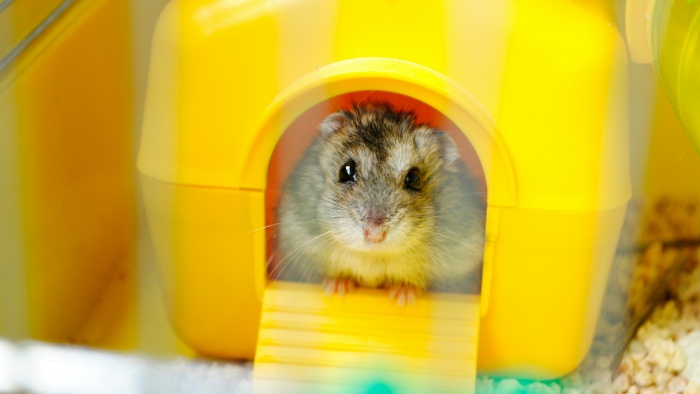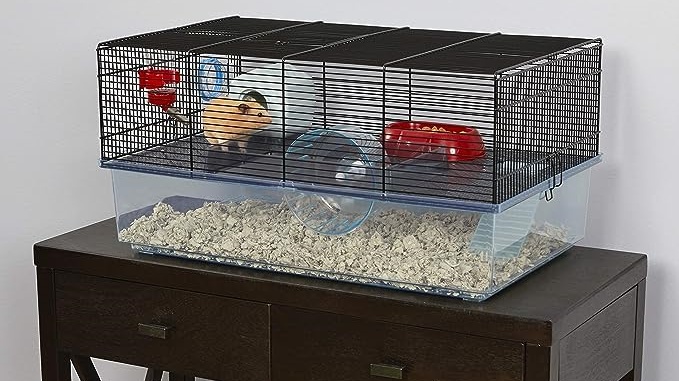
Can You Travel with a Hamster? A Comprehensive Guide
Traveling with a pet hamster isn’t as straightforward as it might seem. It requires careful consideration of your pet’s safety, comfort, and the logistics involved.

Finding the best hamster cage for Syrian hamster is crucial, as these curious, low-maintenance, and independent pets thrive in the right environment. The primary concern is to provide them with ample space, opportunities for exercise, and a cozy sleeping area.
Unique in personality compared to other hamster breeds, Syrian hamsters grow increasingly territorial with age, necessitating additional space due to their larger size. With the correct cage, you can ensure a happy and healthy life for them.
In this guide, we’ll explore the top cage options specifically designed for Syrian hamsters.
Selecting a cage for your Syrian hamster involves weighing various options available in the market, each offering distinct advantages and potential drawbacks.

A suitable cage should provide at least 450 square inches of floor space, ideally 20 gallons or more. To get a clearer picture, consider browsing exotic pet stores for various models.
An excellent choice, the Savic Metro Heaven Extra Large Hamster Cage includes extra toys for enrichment. Despite having one level, its base surface is spacious at 80 x 50 x 50 inches with a 9.5-millimeter bar space. It includes two platforms, feeding bowls, water bottles, houses, a tunnel, and a toilet. Priced at $136, this cage provides a comprehensive setup.
For a simpler choice, the 528 Universal Small Animal Home is perfect. It has a single level with a base measuring 32.5 x 19 x 17.5 inches and 9.6 millimeters in bar spacing. It features two doors, an elevated platform, and a tubby base for burrowing. Priced at $86.99, it’s a solid start, though adding a wheel and toys is advisable.
The Favola cage offers both upper and subterranean levels, with features like a food dish, water bottle, exercise wheel, and hideout. Its surface level measures 23.6 x 14.4 x 11.8 inches. Its lower height prevents falls, and it comes with a one-year warranty for $79.99.
For a playful environment, the Ferplast hamster cage is an excellent option. It’s taller, measuring 18.11 x 11.61 x 14.8 inches, and comes with all necessary accessories, including a play tube. It’s not the largest but offers essential toys for $45.
This uniquely designed arcade home is optimal for entertainment and exercise. It’s 18.11 x 11.61 x 21.26 inches in size, featuring two levels with various platforms, a hideout, and an exercise wheel. The height compensates for the smaller base, priced affordably at $55.
Measuring 28.35 x 5.91 x 14.96 inches, this cage offers a multi-level design with a water bottle, food bowl, wheel, and play tubes. It’s tailored for Syrian hamsters with a 7mm bar gap.
The NatureNest cage is a premium choice, featuring a slot-in top cover design, optional universal wheels, a front transparent door, a wrap-around convection grid, curved door hinges, and an easy landscaping setup. Available in 4 styles, and offering a luxurious and spacious environment for your Syrian hamster.
Getting to know the distinctive traits of your Syrian hamster is crucial for creating an optimal living space.
These pets prefer solitude and do not thrive in shared habitats, so it’s advised to keep only one per cage. Syrian hamsters are inherently nocturnal and territorial, emphasizing the need for a quiet daytime resting area.
Equipping yourself with the appropriate exotic pet accessories is essential. These should cater to their natural instincts of climbing, playing, and burrowing, ensuring their physical and mental well-being.
Selecting the right cage for your Syrian hamster, where they will spend most of their time, is crucial for their happiness and well-being.
A Syrian hamster, which can grow up to 7 inches, requires a spacious cage to thrive. A larger cage supports their development and provides ample space for activities like playing, jumping, eating, drinking, and resting.
For Syrian hamsters, the best cages usually offer a minimum of 450 square inches of base area. This space allows for movement, reaching different levels, and even burrowing if no subterranean levels are present. Besides the base area, the height of the cage is also important. A second floor and platforms are beneficial for climbing and playing.
Once size is determined, the material of the cage is the next consideration. Common materials include plastic, glass, and metal wiring.
Opt for a solid base floor made of glass or plastic to prevent your hamster from getting stuck in any wiring. For the cage walls, metal wiring is often the ideal choice due to its balance of security and ventilation.
For subterranean levels or aquarium-style habitats, glass or plastic can be more suitable. These materials are hamster-friendly and easier to clean.

Good ventilation in your Syrian hamster’s cage is essential. It helps to keep ammonia levels low, prevents the growth of fungi, and maintains a comfortable temperature within the habitat.
For aquariums or lower levels of the cage, an open top is necessary for proper air circulation. Mesh or wire tops are typically the best options for achieving optimal airflow. In contrast, plastic or modular cages often come with built-in holes or vents to facilitate sufficient ventilation.
The design of the cage must also prioritize security, as Syrian hamsters are known for their escape skills. It’s important to inspect all potential exit points, including small openings and gaps.
The spacing between the wires of the cage should be less than half an inch to prevent escape. Hamsters are adept at squeezing through larger gaps if they have the chance. Additionally, ensure that all cage doors are secure, close tightly, and are in good working order to prevent any unexpected escapes.
Selecting the right type of cage is pivotal for creating an ideal environment for your Syrian hamster. Among the various options are wire cages, plastic modular cages, glass tanks, DIY cages, and wooden hamster cages.
Wire cages are a prevalent choice for Syrian hamsters, offering good visibility and ventilation. They are widely available in various designs and levels. One drawback is the potential risk of injury if hamsters climb the wiring.

These cages are favored for their unique designs, allowing hamsters to climb and explore using platforms, wheels, and tubes. However, finding a sufficiently sized plastic modular cage with adequate ventilation can be a challenge.
Glass tanks provide excellent visibility, helping owners monitor their hamsters. They also contain bedding and food effectively. The downsides are their weight, which can be cumbersome for travel, and a potential lack of sufficient ventilation.
Wooden cages offer a natural aesthetic and can be a cozy habitat for hamsters. They often blend well with home decor and provide ample climbing opportunities. However, ensure the wood is untreated and safe, and consider the challenge of cleaning and potential for chewing.
Creating a DIY cage, such as using Ikea Detolf shelves or bin cages, allows for a personalized habitat. While highly customizable, it’s vital to ensure they are safe, well-ventilated, and made from non-toxic materials.
Now that you have the perfect cage and supplies for your Syrian hamster, it’s time to create their home. Choose a room with a stable temperature, away from direct sunlight and loud noises for the cage’s location.
Begin by lining the base or lower level with two to three layers of aspen shavings for bedding. Add a cozy hideout on the same level to serve as a nesting area. Scatter toys, platforms, and the hamster wheel across various levels in the cage for enrichment.
Make sure your hamster can easily reach a hanging water bottle on the base level and a shallow, regularly refilled food dish. Based on your pet’s activity and cleanliness, plan to clean the cage and refresh the bedding every one to two weeks to maintain a healthy environment.
Finding the best hamster cage for Syrian hamster is a thoughtful process that significantly impacts their quality of life. The ideal habitat should cater to their unique needs, providing ample space for growth, exercise, and comfort.
From wire cages offering excellent ventilation to more elaborate setups like the NatureNest cage with accessories, each option presents its benefits.
Remember to consider factors such as cage size, material, ventilation, and security to ensure a safe and stimulating environment for your pet.
By carefully setting up and maintaining the chosen habitat, you can create a delightful and nurturing home for your Syrian hamster, ensuring their happiness and well-being.
What Should I Feed My Syrian Hamster?
While a quality commercial hamster mix is essential, Syrian hamsters also benefit from fresh fruits and vegetables. Avoid citrus fruits and iceberg lettuce. Providing a balanced diet is key to maintaining their health.
How Often Should I Interact with My Syrian Hamster?
Daily interaction is recommended for Syrian hamsters. They are solitary but enjoy human companionship. Handle them gently and allow them time outside the cage in a secure environment for exercise and exploration.
Is It Necessary to Have a Wheel in the Cage?
Yes, exercise wheels are vital for a hamster’s physical health and mental stimulation. Ensure the wheel is large enough to prevent back curvature and solid-surfaced to avoid foot injuries.
Can Syrian Hamsters Coexist with Other Pets?
While Syrian hamsters should be housed alone, they can live in a home with other pets if kept securely and separate. Always supervise any interaction with other pets to ensure safety.
How Do I Know if My Syrian Hamster is Happy and Healthy?
Signs of a happy and healthy Syrian hamster include regular eating and grooming, curiosity, and active behavior. Monitor their health regularly and look for signs of stress or illness, like lethargy or changes in eating habits.


Traveling with a pet hamster isn’t as straightforward as it might seem. It requires careful consideration of your pet’s safety, comfort, and the logistics involved.

When I began, the task of selecting essentials for a natural hamster habitat was daunting. To ease this process, I’ve assembled an exclusive set of

Have you ever wondered, “Are hamsters happier in bigger cages?” Generally YES. It’s a question that might seem straightforward, but there’s more to it than

Hamsters, the small, furry, and often nocturnal creatures, have been popular pets for many years. They are known for their playful nature and ease of

Traveling with a pet hamster isn’t as straightforward as it might seem. It requires careful consideration of your pet’s safety, comfort, and the logistics involved.

Finding the best hamster cage for Syrian hamster is crucial, as these curious, low-maintenance, and independent pets thrive in the right environment. The primary concern

When I began, the task of selecting essentials for a natural hamster habitat was daunting. To ease this process, I’ve assembled an exclusive set of

Have you ever wondered, “Are hamsters happier in bigger cages?” Generally YES. It’s a question that might seem straightforward, but there’s more to it than